Shop for Plans
Shop for your own coverage
Plans through your employer
Learn about the medical, dental, pharmacy, behavioral, and voluntary benefits your employer may offer.
Learn
Looking for Medicare coverage?
Colon Cancer Treatment (PDQ®): Treatment - Patient Information [NCI]
General Information About Colon Cancer
Colon cancer is a type of cancer that forms in the tissues of the colon.
The colon is part of the body's digestive system. The digestive system takes in nutrients (vitamins, minerals, carbohydrates, fats, proteins, and water) from foods and helps pass waste material out of the body. The digestive system is made up of the esophagus, stomach, and the small and large intestines. The colon (large bowel) is the main part of the large intestine and is about 5 feet long. Together, the rectum and anal canal make up the last part of the large intestine and are about 6 to 8 inches long. The anal canal ends at the anus (the opening of the large intestine to the outside of the body).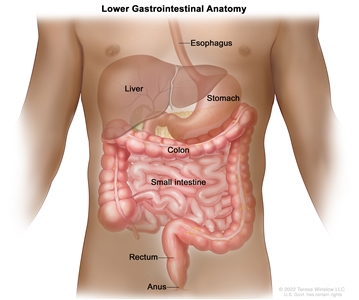
Anatomy of the lower gastrointestinal (digestive) system showing the colon, rectum, and anus. Other organs that make up the digestive system are also shown.
Gastrointestinal stromal tumors can occur in the colon. For more information, visit
Health history affects the risk of developing colon cancer.
Colorectal cancer is caused by certain changes to the way colorectal cells function, especially how they grow and divide into new cells. There are many risk factors for colorectal cancer, but many do not directly cause cancer. Instead, they increase the chance of DNA damage in cells that may lead to colorectal cancer. To learn more about how cancer develops, see
A risk factor is anything that increases the chance of getting a disease. Some risk factors for colorectal cancer, like smoking, can be changed. However, risk factors also include things you cannot change, like your genetics, getting older, and your family history. Learning about risk factors for colorectal cancer can help you make changes that might lower your risk of getting it.
Risk factors for colorectal cancer include:
- having a first-degree relative (parent, sibling, or child) with a history of colon or rectal cancer
- having a personal history of colon, rectal, or ovarian cancer
- having a personal history of high-risk adenomas (colorectal polyps that are 1 centimeter or larger in size or that have cells that look abnormal under a microscope)
- having inherited changes in certain genes that increase the risk of familial adenomatous polyposis (FAP) or Lynch syndrome (hereditary nonpolyposis colorectal cancer)
- having a personal history of chronic ulcerative colitis or Crohn disease for 8 years or more
- having three or more alcoholic drinks per day
- smoking cigarettes
- being Black
- having obesity
Older age is a main risk factor for most cancers. The chance of getting cancer increases as you get older.
Having one or more of these risk factors does not mean that you will get colorectal cancer. Many people with risk factors never develop colorectal cancer, while others with no known risk factors do. Talk with your doctor if you think you might be at increased risk.
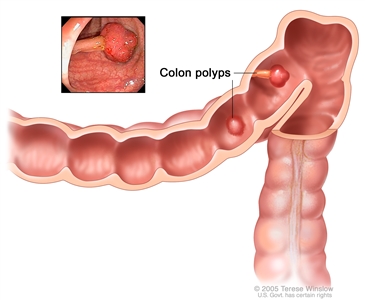
Polyps in the colon. Some polyps have a stalk and others do not. Inset shows a photo of a polyp with a stalk.
Signs of colon cancer include blood in the stool or a change in bowel habits.
These and other signs and symptoms may be caused by colon cancer or by other conditions. Check with your doctor if you have:
- blood (either bright red or very dark) in the stool
- a change in bowel habits
- diarrhea
- constipation
- feeling that the bowel does not empty completely
- stools that are narrower or have a different shape than usual
- general abdominal discomfort (frequent gas pains, bloating, fullness, or cramps)
- weight loss for no known reason
- fatigue
- vomiting
Tests that examine the colon and rectum are used to diagnose colon cancer.
In addition to asking about your personal and family health history and doing a physical exam, your doctor may perform the following tests and procedures:
- Digital rectal exam (DRE) is an exam of the rectum. The doctor or nurse inserts a lubricated, gloved finger into the lower part of the rectum to feel for lumps or anything else that seems unusual.
- Fecal occult blood test (FOBT) is a test to check stool (solid waste) for blood that can only be seen with a microscope. A small sample of stool is placed on a special card or in a special container and returned to the doctor or laboratory for testing. Blood in the stool may be a sign of polyps (small pieces of bulging tissue), cancer, or other conditions.
There are two types of FOBTs:
- Guaiac FOBT: The sample of stool on the special card is tested with a chemical. If there is blood in the stool, the special card changes color.

A guaiac fecal occult blood test (FOBT) checks for occult (hidden) blood in the stool. Small samples of stool are placed on a special card and returned to a doctor or laboratory for testing. - Immunochemical FOBT: A liquid is added to the stool sample. This mixture is injected into a machine that contains antibodies that can detect blood in the stool. If there is blood in the stool, a line appears in a window in the machine. This test is also called fecal immunochemical test or FIT.
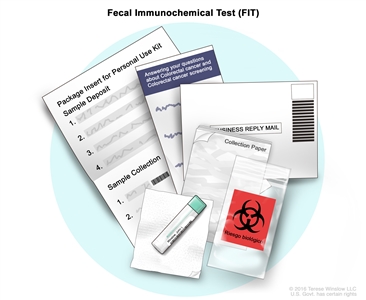
A fecal immunochemical test (FIT) checks for occult (hidden) blood in the stool. A small sample of stool is placed in a special collection tube or on special cards and returned to a doctor or laboratory for testing.
- Guaiac FOBT: The sample of stool on the special card is tested with a chemical. If there is blood in the stool, the special card changes color.
- Sigmoidoscopy is a procedure to look inside the rectum and sigmoid (lower) colon for polyps (small pieces of bulging tissue), abnormal areas, or cancer. A sigmoidoscope is inserted through the rectum into the sigmoid colon. A sigmoidoscope is a thin, tube-like instrument with a light and a lens for viewing. It may also have a tool to remove polyps or tissue samples, which are checked under a microscope for signs of cancer.
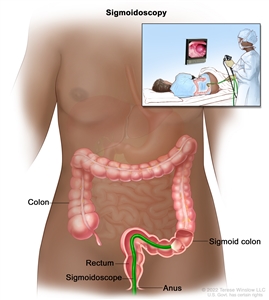
Sigmoidoscopy. A thin, lighted tube is inserted through the anus and rectum and into the lower part of the colon to look for abnormal areas. - Colonoscopy is a procedure that uses a colonoscope to look inside the rectum and colon for polyps (small pieces of bulging tissue), abnormal areas, or cancer. A colonoscope is a thin, tube-like instrument with a light and a lens for viewing. It may also have a tool to remove polyps or tissue samples, which are checked under a microscope for signs of cancer.

Colonoscopy. A thin, lighted tube is inserted through the anus and rectum and into the colon to look for abnormal areas. - Virtual colonoscopy is a procedure that uses a series of x-rays called computed tomography to make a series of pictures of the colon. A computer puts the pictures together to create detailed images that may show polyps and anything else that seems unusual on the inside surface of the colon. This test is also called colonography or CT colonography.
- Biopsy is the removal of cells or tissues so they can be viewed under a microscope to check for signs of cancer. Tumor tissue that is removed during the biopsy may be checked to see if the patient is likely to have the gene mutation that causes Lynch syndrome (also known as hereditary nonpolyposis colorectal cancer). This may help to plan treatment. Learn about the type of information that can be found in a pathologist's report about the cells or tissue removed during a biopsy at
Pathology Reports . - DNA stool test checks DNA in stool cells for genetic changes that may be a sign of colorectal cancer.
After colon cancer has been diagnosed, imaging tests are done to find out if cancer cells have spread within the colon or to other parts of the body.
The process used to find out whether cancer has spread within the colon or to other parts of the body is called staging. The information gathered from the staging process determines the stage of the disease. It is important to know the stage in order to plan treatment.
The following tests and procedures may be used in the staging process:
- CT scan (CAT scan) uses a computer linked to an x-ray machine to make a series of detailed pictures of areas inside the body, such as the abdomen, pelvis, or chest. The pictures are taken from different angles and are used to create 3-D views of tissues and organs. A dye may be injected into a vein or swallowed to help the organs or tissues show up more clearly. This procedure is also called computed tomography, computerized tomography, or computerized axial tomography.
- MRI (magnetic resonance imaging) uses a magnet, radio waves, and a computer to make a series of detailed pictures of areas inside the colon. A substance called gadolinium is injected into the patient through a vein. The gadolinium collects around the cancer cells so they show up brighter in the picture. This procedure is also called nuclear magnetic resonance imaging (NMRI).
- PET scan (positron emission tomography scan) uses a small amount of radioactive sugar (also called glucose) that is injected into a vein. Then a scanner rotates around the body to make detailed, computerized pictures of areas inside the body where the glucose is taken up. Because cancer cells often take up more glucose than normal cells, the pictures can be used to find cancer cells in the body.
- Chest x-ray is a type of radiation that can go through the body and make pictures of the organs and bones inside the chest.
- Surgery is a procedure to remove the tumor and see how far it has spread through the colon.
- Lymph node biopsy is the removal of all or part of a lymph node. A pathologist views the lymph node tissue under a microscope to check for cancer cells. This may be done during surgery or by endoscopic ultrasound-guided fine needle aspiration biopsy.
- Carcinoembryonic antigen (CEA) assay is a test that measures the level of CEA in the blood. CEA is released into the bloodstream from both cancer cells and normal cells. When found in higher than normal amounts, it can be a sign of colon cancer or other conditions.
Some people decide to get a second opinion.
You may want to get a second opinion to confirm your colon cancer diagnosis and treatment plan. If you seek a second opinion, you will need to get medical test results and reports from the first doctor to share with the second doctor. The second doctor will review the pathology report, slides, and scans. They may agree with the first doctor, suggest changes or another treatment approach, or provide more information about your cancer.
Learn more about choosing a doctor and getting a second opinion at
Certain factors affect prognosis (chance of recovery) and treatment options.
The prognosis and treatment options depend on:
- the stage of the cancer (whether it affects the inner lining of the colon only, or has spread to lymph nodes, nearby organs, or other places in the body)
- the level of CEA in the blood
- whether the cancer is related to certain genetic changes in stool cells
- whether the tumor has spread into or through the colon wall
- whether the colon is blocked or has a hole in it
- whether all of the tumor can be removed by surgery
- the patient's general health
- whether the cancer has just been diagnosed or has recurred (come back)
Stages of Colon Cancer
Cancer stage describes the extent of cancer in the body, such as the size of the tumor, whether it has spread, and how far it has spread from where it first formed. It is important to know the stage of the colon cancer to plan the best treatment.
There are several staging systems for cancer that describe the extent of the cancer. Colon cancer staging usually uses the TNM staging system. The cancer may be described by this staging system in your pathology report. Based on the TNM results, a stage (I, II, III, or IV, also written as 1, 2, 3, or 4) is assigned to your cancer. When talking to you about your diagnosis, your doctor may describe the cancer as one of these stages.
Learn about
The following stages are used for colon cancer:
Stage 0 (carcinoma in situ)

Stage 0 (colon carcinoma in situ). Abnormal cells are shown in the mucosa of the colon wall.
In stage 0 colon cancer, abnormal cells are found in the mucosa (innermost layer) of the colon wall. These abnormal cells may become cancer and spread into nearby normal tissue. Stage 0 is also called carcinoma in situ.
Stage I (also called stage 1) colon cancer
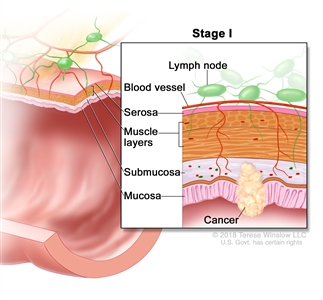
Stage I colon cancer. Cancer has spread from the mucosa of the colon wall to the submucosa or to the muscle layer.
In stage I colon cancer, cancer has formed in the mucosa (innermost layer) of the colon wall and has spread to the submucosa (layer of tissue next to the mucosa) or to the muscle layer of the colon wall.
Stage II (also called stage 2) colon cancer
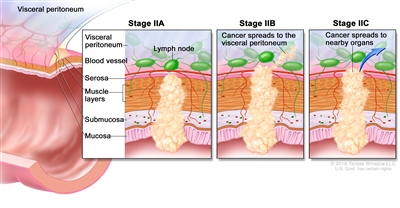
Stage II colon cancer. In stage IIA, cancer has spread through the muscle layer of the colon wall to the serosa. In stage IIB, cancer has spread through the serosa but has not spread to nearby organs. In stage IIC, cancer has spread through the serosa to nearby organs.
Stage II colon cancer is divided into stages IIA, IIB, and IIC.
- Stage IIA: Cancer has spread through the muscle layer of the colon wall to the serosa (outermost layer) of the colon wall.
- Stage IIB: Cancer has spread through the serosa (outermost layer) of the colon wall to the tissue that lines the organs in the abdomen (visceral peritoneum).
- Stage IIC: Cancer has spread through the serosa (outermost layer) of the colon wall to nearby organs.
Stage III (also called stage 3) colon cancer
Stage III colon cancer is divided into stages IIIA, IIIB, and IIIC.
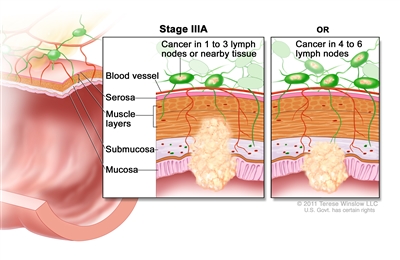
Stage IIIA colon cancer. Cancer has spread through the mucosa of the colon wall to the submucosa and may have spread to the muscle layer, and has spread to one to three nearby lymph nodes or tissues near the lymph nodes. OR, cancer has spread through the mucosa to the submucosa and four to six nearby lymph nodes.
In stage IIIA, cancer has spread:
- through the mucosa (innermost layer) of the colon wall to the submucosa (layer of tissue next to the mucosa) or to the muscle layer of the colon wall. Cancer has spread to one to three nearby lymph nodes, or cancer cells have formed in tissue near the lymph nodes; or
- through the mucosa (innermost layer) of the colon wall to the submucosa (layer of tissue next to the mucosa). Cancer has spread to four to six nearby lymph nodes.

Stage IIIB colon cancer. Cancer has spread through the muscle layer of the colon wall to the serosa or has spread through the serosa but not to nearby organs; cancer has spread to one to three nearby lymph nodes or to tissues near the lymph nodes. OR, cancer has spread to the muscle layer or to the serosa, and to four to six nearby lymph nodes. OR, cancer has spread through the mucosa to the submucosa and may have spread to the muscle layer; cancer has spread to seven or more nearby lymph nodes.
In stage IIIB, cancer has spread:
- through the muscle layer of the colon wall to the serosa (outermost layer) of the colon wall or has spread through the serosa to the tissue that lines the organs in the abdomen (visceral peritoneum). Cancer has spread to one to three nearby lymph nodes, or cancer cells have formed in tissue near the lymph nodes; or
- to the muscle layer or to the serosa (outermost layer) of the colon wall. Cancer has spread to four to six nearby lymph nodes; or
- through the mucosa (innermost layer) of the colon wall to the submucosa (layer of tissue next to the mucosa) or to the muscle layer of the colon wall. Cancer has spread to seven or more nearby lymph nodes.
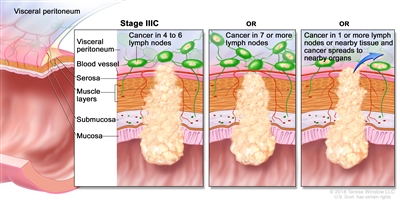
Stage IIIC colon cancer. Cancer has spread through the serosa of the colon wall but not to nearby organs; cancer has spread to four to six nearby lymph nodes. OR, cancer has spread through the muscle layer to the serosa or has spread through the serosa but not to nearby organs; cancer has spread to seven or more nearby lymph nodes. OR, cancer has spread through the serosa to nearby organs and to one or more nearby lymph nodes or to tissues near the lymph nodes.
In stage IIIC, cancer has spread:
- through the serosa (outermost layer) of the colon wall to the tissue that lines the organs in the abdomen (visceral peritoneum). Cancer has spread to four to six nearby lymph nodes; or
- through the muscle layer of the colon wall to the serosa (outermost layer) of the colon wall or has spread through the serosa to the tissue that lines the organs in the abdomen (visceral peritoneum). Cancer has spread to seven or more nearby lymph nodes; or
- through the serosa (outermost layer) of the colon wall to nearby organs. Cancer has spread to one or more nearby lymph nodes, or cancer cells have formed in tissue near the lymph nodes.
Stage IV (also called stage 4) colon cancer
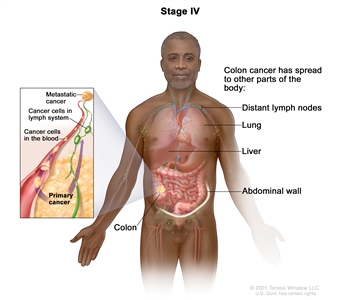
Stage IV colon cancer. The cancer has spread through the blood and lymph nodes to other parts of the body, such as the lung, liver, abdominal wall, or ovary (in females).
Stage IV colon cancer is divided into stages IVA, IVB, and IVC.
- Stage IVA: Cancer has spread to one area or organ that is not near the colon, such as the liver, lung, ovary, or a distant lymph node.
- Stage IVB: Cancer has spread to more than one area or organ that is not near the colon, such as the liver, lung, ovary, or a distant lymph node.
- Stage IVC: Cancer has spread to the tissue that lines the wall of the abdomen and may have spread to other areas or organs.
Stage IV colon cancer is also called metastatic colon cancer. Metastatic cancer happens when cancer cells travel through the lymphatic system or blood and form tumors in other parts of the body. The metastatic tumor is the same type of cancer as the primary tumor. For example, if colon cancer spreads to the liver, the cancer cells in the liver are actually colon cancer cells. The disease is called metastatic colon cancer, not liver cancer. Learn more in
Colon cancer can recur (come back) after it has been treated.
Recurrent colon cancer is cancer that has come back after it has been treated. If colon cancer comes back, it may come back in the colon or in other parts of the body, such as the liver, lungs, or both. Tests will be done to help determine where the cancer has returned. The type of treatment for recurrent colon cancer will depend on where it has come back.
Learn more in
Treatment Option Overview
There are different types of treatment for people with colon cancer.
Different types of treatments are available for colon cancer. You and your cancer care team will work together to decide your treatment plan, which may include more than one type of treatment. Many factors will be considered, such as the stage of the cancer, your overall health, and your preferences. Your plan will include information about your cancer, the goals of treatment, your treatment options and the possible side effects, and the expected length of treatment.
Talking with your cancer care team before treatment begins about what to expect will be helpful. You'll want to learn what you need to do before treatment begins, how you'll feel while going through it, and what kind of help you will need. To learn more, visit
The following types of treatment are used:
Surgery
Surgery is the most common treatment for all stages of colon cancer. The cancer is removed using one of the following types of surgery:
- Polypectomy: If the cancer is found in a polyp (a small piece of bulging tissue), the polyp is often removed during a colonoscopy.
- Local excision: If the cancer is found at a very early stage, the doctor may remove it without cutting through the abdominal wall. Instead, the doctor may put a tube with a cutting tool through the rectum into the colon and cut the cancer out. This is called a local excision.
- Resection of the colon with anastomosis: If the cancer is larger, the doctor will perform a partial colectomy (removing the cancer and a small amount of healthy tissue around it). The doctor may then perform an anastomosis (sewing the healthy parts of the colon together). The doctor will also usually remove lymph nodes near the colon and examine them under a microscope to see whether they contain cancer.
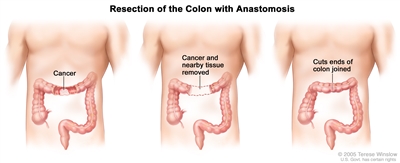
Resection of the colon with anastomosis. Part of the colon containing the cancer and nearby healthy tissue is removed, and then the cut ends of the colon are joined. - Resection of the colon with colostomy: If the doctor is not able to sew the two ends of the colon back together, a stoma (opening) is made on the outside of the body for waste to pass through. This procedure is called a colostomy. A bag is placed around the stoma to collect the waste. Sometimes the colostomy is needed only until the lower colon has healed, and then it can be reversed. If the doctor needs to remove the entire lower colon, however, the colostomy may be permanent.
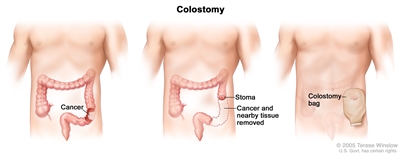
Colon cancer surgery with colostomy. Part of the colon containing the cancer and nearby healthy tissue is removed, a stoma is created, and a colostomy bag is attached to the stoma. - Radiofrequency ablation: The use of a special probe with tiny electrodes that kill cancer cells. Sometimes, the probe is inserted directly through the skin, and only local anesthesia is needed. In other cases, the probe is inserted through an incision in the abdomen. This is done in the hospital with general anesthesia.
- Cryosurgery: A treatment that uses an instrument to freeze and destroy abnormal tissue. This type of treatment is also called cryotherapy. Learn more about
Cryosurgery to Treat Cancer .
Radiation therapy and/or chemotherapy may be given before surgery to shrink the tumor, make it easier to remove the cancer, and help with bowel control after surgery. Treatment given before surgery is called neoadjuvant therapy. After all the cancer that can be seen at the time of the surgery is removed, some patients may be given radiation therapy and/or chemotherapy after surgery to kill any cancer cells that are left. Treatment given after the surgery, to lower the risk that the cancer will come back, is called adjuvant therapy.
If the cancer has spread to the liver and cannot be removed by surgery, a total hepatectomy and liver transplant after chemotherapy may be done. Total hepatectomy and liver transplant is the removal of the entire liver by surgery, followed by a transplant of a healthy liver from a donor.
Chemotherapy
Chemotherapy (also called chemo) uses drugs to stop the growth of cancer cells, either by killing the cells or by stopping them from dividing.
Systemic chemotherapy is when chemotherapy drugs are taken by mouth or injected into a vein or muscle. When given this way, the drugs enter the bloodstream and can reach cancer cells throughout the body. Systemic chemotherapy used to treat colon cancer includes:
- capecitabine
- fluorouracil (5-FU)
- irinotecan
- leucovorin (a vitamin that improves the effectiveness of 5-FU)
- oxaliplatin
- trifluridine and tipiracil
Combinations of these drugs may be used. Other chemotherapy drugs not listed here may also be used.
Chemotherapy may also be combined with other kinds of drugs. For example, it might be combined with the targeted therapy drug bevacizumab, cetuximab, or panitumumab.
Regional chemotherapy for colon cancer is when drugs are placed directly into the hepatic artery (the main artery that supplies blood to the liver) in a procedure called chemoembolization. Chemoembolization of the hepatic artery may be used to treat cancer that has spread to the liver. This is done by blocking the hepatic artery and injecting anticancer drugs between the blockage and the liver. The liver's arteries then carry the drugs into the liver. Only a small amount of the drug reaches other parts of the body. The blockage may be temporary or permanent, depending on what is used to block the artery. The liver continues to receive some blood from the hepatic portal vein, which carries blood from the stomach and intestine.
The way the chemotherapy is given depends on the type and stage of the cancer being treated.
Learn more about how chemotherapy works, how it is given, common side effects, and more at
Radiation therapy
Radiation therapy uses high-energy x-rays or other types of radiation to kill cancer cells or keep them from growing. Colon cancer is sometimes treated with two types of radiation therapy used to treat colon cancer:
- External radiation therapy uses a machine outside the body to send radiation toward the area of the body with cancer.
- Internal radiation therapy uses a radioactive substance sealed in needles, seeds, wires, or catheters that are placed directly into or near the cancer. Internal radiation therapy may be used to treat colon cancer that has spread to the liver.
Learn more about
Targeted therapy
Targeted therapy uses drugs or other substances to identify and attack specific cancer cells. Your doctor may suggest biomarker tests to help predict your response to certain targeted therapy drugs. Learn more about
Targeted therapies used to treat colon cancer include:
- bevacizumab
- cetuximab
- encorafenib
- fruquintinib
- panitumumab
- ramucirumab
- regorafenib
- ziv-aflibercept
Learn more about
Immunotherapy
Immunotherapy helps a person's immune system fight cancer. Your doctor may suggest biomarker tests to help predict your response to certain immunotherapy drugs. Learn more about
Immunotherapy drugs used to treat colon cancer include:
- ipilimumab
- nivolumab
- pembrolizumab
Learn more about
New types of treatment are being tested in clinical trials.
For some people, joining a clinical trial may be an option. There are different types of clinical trials for people with cancer. For example, a treatment trial tests new treatments or new ways of using current treatments. Supportive care and palliative care trials look at ways to improve quality of life, especially for those who have side effects from cancer and its treatment.
You can use the
Learn more about clinical trials, including how to find and join one, at
Treatment for colon cancer may cause side effects.
For information about side effects caused by treatment for cancer, visit our
Follow-up care may be needed.
As you go through treatment, you will have follow-up tests or check-ups. Some tests that were done to diagnose or stage the cancer may be repeated to see how well the treatment is working. Decisions about whether to continue, change, or stop treatment may be based on the results of these tests.
Some of the tests will continue to be done from time to time after treatment has ended. The results of these tests can show if your condition has changed or if the cancer has recurred (come back).
After treatment for colon cancer, a blood test to measure amounts of carcinoembryonic antigen (a substance in the blood that may be increased when cancer is present) may be done to see if the cancer has come back.
Treatment of Stage 0 (carcinoma in situ)
Treatment of stage 0 may include the following types of surgery:
- simple polypectomy
- local excision
- resection and anastomosis (when the tumor is too large to remove by local excision)
Learn more about these treatments in the
Use our
Treatment of Stages I and II Colon Cancer
Treatment of stage I colon cancer and stage II colon cancer may include resection and anastomosis.
Learn more about these treatments in the
Use our
Treatment of Stage III Colon Cancer
Treatment of stage III colon cancer may include resection and anastomosis, which may be followed by chemotherapy.
Learn more about these treatments in the
Use our
Treatment of Stage IV and Recurrent Colon Cancer
Treatment of stage IV colon cancer, recurrent colon cancer, and liver metastasis may include:
- local excision for tumors that have recurred
- resection with or without anastomosis
- surgery to remove parts of other organs, such as the liver, lungs, and ovaries, where the cancer may have recurred or spread
- radiation therapy or chemotherapy, as palliative therapy to relieve symptoms and improve quality of life
- chemotherapy with or without targeted therapy (bevacizumab, cetuximab, fruquintinib, panitumumab, ramucirumab, or regorafenib, or ziv-aflibercept)
- targeted therapy with encorafenib and cetuximab in patients with a certain change in the BRAF gene
- immunotherapy (nivolumab or pembrolizumab, or nivolumab and ipilimumab combined)
Treatment of cancer that has spread to the liver may also include:
- chemotherapy given before surgery to shrink the tumor, after surgery, or both before and after
- radiofrequency ablation or cryosurgery, for patients who cannot have surgery
- chemoembolization of the hepatic artery
- liver transplant after chemotherapy for patients with liver metastases that cannot be removed by surgery
Learn more about these treatments in the
Use our
To Learn More About Colon Cancer
For more information from the National Cancer Institute about colon cancer, visit:
-
Colorectal Cancer Home Page -
Screening Tests to Detect Colorectal Cancer and Polyps -
Drugs Approved for Colon and Rectal Cancer -
Genetic Testing for Inherited Cancer Risk
For general cancer information and other resources from the National Cancer Institute, visit:
-
About Cancer -
Cancer Staging -
Chemotherapy and You: Support for People With Cancer -
Radiation Therapy and You: Support for People With Cancer -
Coping with Cancer -
Questions to Ask Your Doctor about Cancer -
For Survivors, Caregivers, and Advocates
About This PDQ Summary
About PDQ
Physician Data Query (PDQ) is the National Cancer Institute's (NCI's) comprehensive cancer information database. The PDQ database contains summaries of the latest published information on cancer prevention, detection, genetics, treatment, supportive care, and complementary and alternative medicine. Most summaries come in two versions. The health professional versions have detailed information written in technical language. The patient versions are written in easy-to-understand, nontechnical language. Both versions have cancer information that is accurate and up to date and most versions are also available in
PDQ is a service of the NCI. The NCI is part of the National Institutes of Health (NIH). NIH is the federal government's center of biomedical research. The PDQ summaries are based on an independent review of the medical literature. They are not policy statements of the NCI or the NIH.
Purpose of This Summary
This PDQ cancer information summary has current information about the treatment of colon cancer. It is meant to inform and help patients, families, and caregivers. It does not give formal guidelines or recommendations for making decisions about health care.
Reviewers and Updates
Editorial Boards write the PDQ cancer information summaries and keep them up to date. These Boards are made up of experts in cancer treatment and other specialties related to cancer. The summaries are reviewed regularly and changes are made when there is new information. The date on each summary ("Updated") is the date of the most recent change.
The information in this patient summary was taken from the health professional version, which is reviewed regularly and updated as needed, by the
Clinical Trial Information
A clinical trial is a study to answer a scientific question, such as whether one treatment is better than another. Trials are based on past studies and what has been learned in the laboratory. Each trial answers certain scientific questions in order to find new and better ways to help cancer patients. During treatment clinical trials, information is collected about the effects of a new treatment and how well it works. If a clinical trial shows that a new treatment is better than one currently being used, the new treatment may become "standard." Patients may want to think about taking part in a clinical trial. Some clinical trials are open only to patients who have not started treatment.
Clinical trials can be found online at
Permission to Use This Summary
PDQ is a registered trademark. The content of PDQ documents can be used freely as text. It cannot be identified as an NCI PDQ cancer information summary unless the whole summary is shown and it is updated regularly. However, a user would be allowed to write a sentence such as "NCI's PDQ cancer information summary about breast cancer prevention states the risks in the following way: [include excerpt from the summary]."
The best way to cite this PDQ summary is:
PDQ® Adult Treatment Editorial Board. PDQ Colon Cancer Treatment. Bethesda, MD: National Cancer Institute. Updated <MM/DD/YYYY>. Available at:
Images in this summary are used with permission of the author(s), artist, and/or publisher for use in the PDQ summaries only. If you want to use an image from a PDQ summary and you are not using the whole summary, you must get permission from the owner. It cannot be given by the National Cancer Institute. Information about using the images in this summary, along with many other images related to cancer can be found in
Disclaimer
The information in these summaries should not be used to make decisions about insurance reimbursement. More information on insurance coverage is available on Cancer.gov on the
Contact Us
More information about contacting us or receiving help with the Cancer.gov website can be found on our
Last Revised: 2025-03-10
If you want to know more about cancer and how it is treated, or if you wish to know about clinical trials for your type of cancer, you can call the NCI's Cancer Information Service at 1-800-422-6237, toll free. A trained information specialist can talk with you and answer your questions.
This information does not replace the advice of a doctor. Ignite Healthwise, LLC, disclaims any warranty or liability for your use of this information. Your use of this information means that you agree to the
Healthwise, Healthwise for every health decision, and the Healthwise logo are trademarks of Ignite Healthwise, LLC.
Page Footer
I want to...
Audiences
Secure Member Sites
The Cigna Group Information
Disclaimer
Individual and family medical and dental insurance plans are insured by Cigna Health and Life Insurance Company (CHLIC), Cigna HealthCare of Arizona, Inc., Cigna HealthCare of Illinois, Inc., Cigna HealthCare of Georgia, Inc., Cigna HealthCare of North Carolina, Inc., Cigna HealthCare of South Carolina, Inc., and Cigna HealthCare of Texas, Inc. Group health insurance and health benefit plans are insured or administered by CHLIC, Connecticut General Life Insurance Company (CGLIC), or their affiliates (see
All insurance policies and group benefit plans contain exclusions and limitations. For availability, costs and complete details of coverage, contact a licensed agent or Cigna sales representative. This website is not intended for residents of New Mexico.